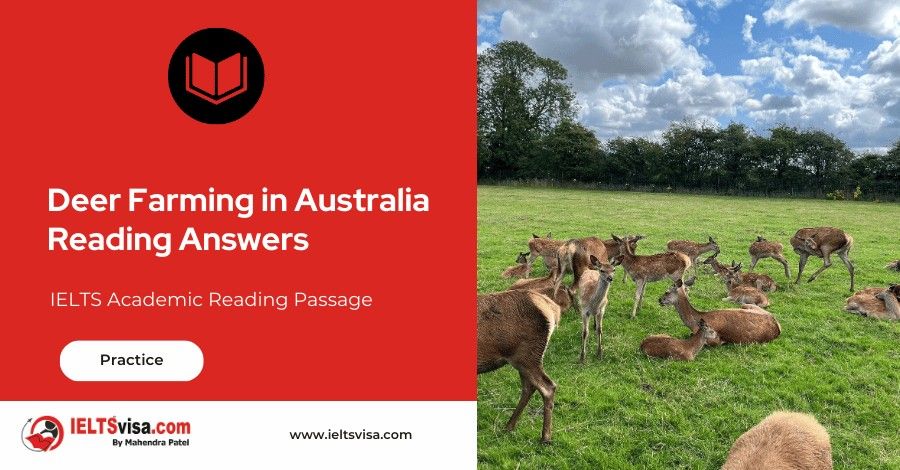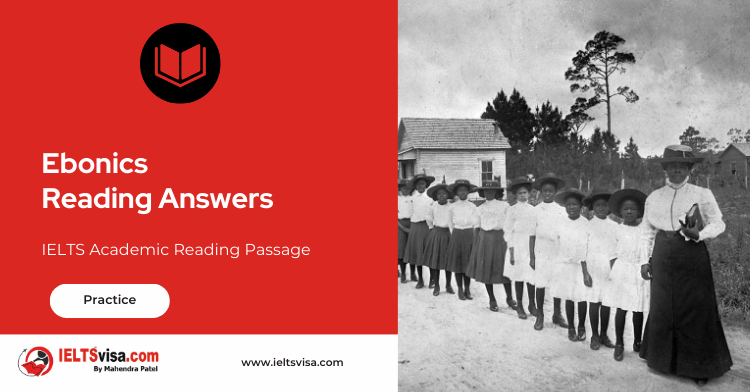Deer Farming in Australia Reading Answers
IELTS Academic Reading Passage
Paragraph A
Deer are not indigenous to Australia. They were introduced into the country during the nineteenth century under the acclimatization programs governing the introduction of exotic species of animals and birds into Australia. Six species of deer were released at various locations. The animals dispersed and established wild populations at various locations across Australia, mostly depending upon their points of release into the wild. These animals formed the basis for the deer industry in Australia today.
Commercial deer farming in Australia commenced in Victoria in 1971 with the authorized capture of rusa deer from the Royal National Park, NSW. Until 1985, only four species of deer, two from temperate climates (red, yellow) and two tropical species (rusa, chital) were confined for commercial farming. Late in 1985, pressure from industry to increase herd numbers saw the development of import protocols. This resulted in the introduction of large numbers of red deer hybrids from New Zealand and North American elk directly from Canada. The national farmed deer herd is now distributed throughout all states although most are in New South Wales and Victoria.
Paragraph B
The number of animals processed annually has continued to increase, despite the downward trend in venison prices since 1997. Of concern is the apparent increase in the number of female animals processed and the number of whole herds committed for processing. With more than 40,000 animals processed in 1998/99 and 60,000 in 1999/2000, there is justified concern that future years may see a dramatic drop in production. At least 85% of all venison produced in Australia is exported, principally to Europe. At least 90% of all velvet antler produced is exported in an unprocessed state to Asia.
Schemes to promote Australian deer products continue to have a positive effect on sales that in turn have a positive effect on prices paid to growers. The industry appears to be showing limited signs that it is emerging from a state of depression caused by both internal and external factors that include: (i) the Asian currency downturn; (ii) the industry’s lack of competitive advantage in influential markets (particularly in respect to New Zealand competition), and (iii) within industry processing and marketing competition for limited product volumes of venison.
Paragraph C
From the formation of the Australian Deer Breeders Federation in 1979, the industry representative body has evolved through the Deer Farmers Federation of Australia to the Deer Industry Association of Australia Ltd (DIAA), which was registered in 1995. The industry has established two product development and marketing companies, the Australian Deer Horn and Co-Products Pty Ltd (ADH) and the Deer Industry Projects and Development Pty Ltd, which trades as the Deer Industry Company (DIC). ADH collects and markets Australian deer horn and co-products on behalf of Australian deer farmers. It promotes the harvest of velvet antler according to the strict quality assurance program promoted by the industry. The company also plans and coordinates regular velvet accreditation courses for Australian deer farmers.
Paragraph D
Estimates suggest that until the early 1990s the rate of the annual increase in the number of farmed deer was up to 25%, but after 1993 this rate of increase fell to probably less than 10%. The main reasons for the decline in the deer herd growth rate at such a critical time for the market were: (i) severe drought conditions up to 1998 affecting eastern Australia during 1993-96 and (ii) the consequent slaughter of large numbers of breeding females, at very low prices. These factors combined to decrease confidence within the industry. Lack of confidence saw a drop in new investment within the industry and a lack of willingness of established farmers to expand their herds. With the development of strong overseas markets for venison and velvet and the prospect of better seasons ahead in 1996, the trends described were seen to have been significantly reversed. However, the relatively small size of the Australian herd was seen to impose undesirable restraints on the rate at which herd numbers could be expanded to meet the demands for products. Supply difficulties were exacerbated when the supply of products, particularly venison, was maintained by the slaughter of young breeding females. The net result was depletion of the industry ’s female breeding herds.
Paragraph E
Industry programs are funded by statutory levies on sales of animals for venison, velvet antler sales and the sale of live animals into export markets. The industry has a 1996-2000 five year plan including animal nutrition, pasture quality, carcass quality, antler harvesting, promotional material and technical bulletins. All projects have generated a significant volume of information, which complements similar work undertaken in New Zealand and other deer farming countries.
Major projects funded by levy funds include the Venison Market Project from 1992 to 1996. This initiative resulted in a dramatic increase in international demand for Australian venison and an increase in the domestic consumption of venison. In an effort to maintain existing venison markets in the short term and to increase them in the long term, in 1997 the industry’s top priority became the increase in size and production capacity of the national herd.
Question 28-32:
The reading passage on Deer Farming In Australia has 5 paragraphs (A-E).
From the list of headings below choose the most suitable headings for paragraphs A – E.
Write the appropriate number (i – viii) in boxes 28 – 32 on your answer sheet.
NB There are more headings than paragraphs, so you will not use them all.
(i) Industry Structures
(ii) Disease Affects Production
(iii) Trends in Production
(iv) Government Assistance
(v) How Deer Came to Australia
(vi) Research and Development
(vii) Asian Competition
(viii) Industry Development
28 Paragraph A
29 Paragraph B
30 Paragraph C
31 Paragraph D
32 Paragraph E
Questions 33-37
Read the passage about Deer Farming in Australia again and look at the statements below.
In boxes 33 — 37 on your answer sheet write:
TRUE if the statement is true
FALSE if the statement is false
NOT GIVEN if the information is not given in Reading Passage 3
33 Until 1985 only 2 species Of the originally released Australian deer were not used for farming.
34 Since 1985 many imported deer have been interbred with the established herds.
35 The drop in deer numbers since 1997 led to an increase in the price of venison.
36 Only a small amount of Australian venison production is consumed domestically.
37 Current economic conditions in Asian countries have had positive effect on the Australian deer industry.
Questions 38 — 40
Complete each of the following statements (Questions 38 — 40) with words taken from Reading Passage 3. Write NO MORE THAN THREE WORDS for each answer. Write your answers in boxes 38 — 40 on your answer sheet.
38 A stringent………………….. the Australian deer industry to maintain their excellence of product.
39 Herd stock expansion was made difficult by the killing of …………………….. Continue product supply.
40 Foreign and home markets for Australian venison increased due to ……………………..

Solution For: Deer Farming in Australia
Reading Answers
| 28. V | 35. false |
| 29. viii | 36. true |
| 30. i | 37. not given |
| 31. iii | 38. quality assurance programme |
| 32. vi | 39. breeding females |
| 33. true | 40. venison market project |
| 34. not given |
Review and Practice
- Regularly practice with IELTS reading samples and time yourself to get used to the pressure of the exam.
- Review your mistakes to understand where you went wrong and how to avoid similar errors in the future.
Our Books
Master IELTS Speaking Part 1
IELTS Writing Task 1 Book
IELTS Writing Task 2 Book
Deer Farming in Australia Reading Answers Explanation
Comin Soon
Practice IELTS Other Modules
IELTS Listening
The IELTS Listening test assesses how well you can understand spoken English in various contexts. It lasts about 30 minutes and is divided into four sections with a total of 40 questions. The listening tasks become increasingly difficult as the test progresses.
IELTS Academic Reading
The IELTS Academic Reading section assesses your ability to understand and interpret a variety of texts in academic settings. It is designed to evaluate a range of reading skills, including skimming for gist, reading for main ideas, reading for detail, understanding inferences, and recognizing a writer's opinions and arguments.
IELTS Speaking
The IELTS Speaking test assesses your ability to communicate in English on everyday topics. It lasts 11-14 minutes and consists of three parts: introduction, cue card, and a discussion based on the cue card topic.
IELTS General Reading
IELTS General Reading tests your ability to understand and interpret various types of texts. Here are some key areas and types of content you can expect to encounter in the reading section, along with tips for effective preparation.
IELTS Academic Writing Task 1
In IELTS Academic Writing Task 1, you are presented with a visual representation of information, such as graphs, charts, tables, or diagrams, and you are required to summarize, compare, or explain the data in your own words.
IELTS General Writing Task 1
In IELTS General Writing Task 1, you are required to write a letter based on a given situation. The letter can be formal, semi-formal, or informal, depending on the prompt. Here’s a breakdown of the key components to include in your letter
IELTS Academic Writing Task 2
In IELTS Academic Writing Task 2, you are required to write an essay in response to a question or topic. Here’s a guide to help you understand the essential elements of this task
IELTS Exam Tips
To succeed in the IELTS exam, practice regularly, familiarize yourself with the test format, improve your vocabulary, develop time management skills, and take mock tests to build confidence.
Grammer for IELTS
Grammar is the foundation of effective communication in English. Understanding tense usage, subject-verb agreement, and sentence structure enhances clarity and coherence in writing and speaking.
Vocabulary for IELTS
Vocabulary plays a crucial role in the IELTS (International English Language Testing System) exam, especially in the Speaking and Writing sections. Here’s an overview of why vocabulary is important and how it impacts your performance
RECENT IELTS SAMPLES QUESTIONS AND ANSWERS
Ebonics Reading Answers
A. Ebonics - also known by a host of other names such as African American Vernacular English,...
A Disaster Of Titanic Proportions
A. At 11:39 p.m. on the evening of Sunday, 14 April 1912, lookouts Frederick Fleet and...
Vitamins To supplement or not?
Mineral, vitamin, and antioxidant health supplements make up a multi-billion-dollar industry...
The Hollywood film industry
A. This chapter examines the ‘Golden Age’ of the Hollywood film studio system and explores how...
Three Dimensional Films Reading Answers
A. In the theatre of the Ambassador Hotel in Los Angeles, on the evening of 27 September 1922,...
The Developing World Reading Answers
A THE DEVELOPING WORLD — the economically underdeveloped countries of Asia. Africa. Oceania...













